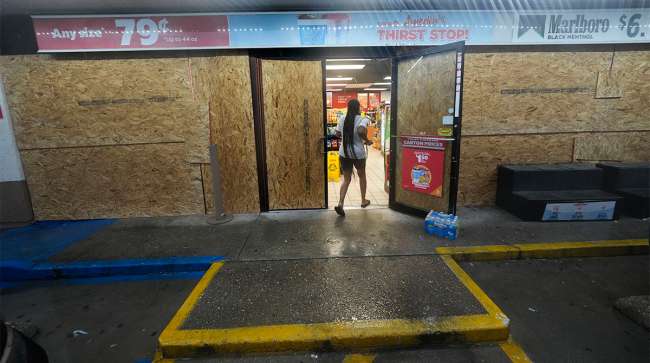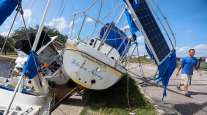Associated Press
Hurricane Francine Nears Louisiana as Category 2 Storm

[Stay on top of transportation news: Get TTNews in your inbox.]
MORGAN CITY, La. — Hurricane Francine barreled toward Louisiana on Sept. 11, strengthening to a Category 2 storm that could bring deadly storm surge, widespread flooding and destructive winds on the northern U.S. Gulf coast.
The hurricane was expected to make landfall later in the day, crashing into a fragile coastal region that hasn’t fully recovered from a series of devastating hurricanes in 2020 and 2021.
In Morgan City, La., gas stations had put plywood on the windows and moved trash cans inside, with a few pumps still serving the trickle of cars passing through shortly after dawn.
Retired boat captain Pat Simon, 75, and his wife, Ruth, had loaded all their possessions in garbage bags and tied them down in the back of a rented U-Haul pickup truck as they evacuated their home near the banks of the Atchafalaya River near Morgan City.
7am CDT Sep 11th -- Here is the latest experimental cone graphic for #Hurricane #Francine showing all coastal and inland wind watches & warnings.
Blog post on this new product: https://t.co/nb95N8DrHy
We want your feedback! Fill out the survey: https://t.co/zJEm4Msebh pic.twitter.com/J3pxrvr0fL — National Hurricane Center (@NHC_Atlantic) September 11, 2024
The U.S. is now in the teeth of hurricane season — which typically peaks around this time of year — but Pat Simon wasn’t overly concerned about Francine.
“I don’t think it’s going to be that bad, like some of the other ones like Ida and Katrina,” he said. “I mean, we’ve had some bad ones.”
Francine drew fuel from exceedingly warm Gulf of Mexico waters, strengthening from a Category 1 to a Category 2 storm, with winds of 96 to 110 mph, according to the National Hurricane Center.
“I know that we have been through a lot here in Louisiana, but I urge everyone to take the necessary preparations,” said Louisiana Gov. Jeff Landry, who urged residents to “stay off the roads, stay home and stay put.”
This federal assistance will be pivotal to save lives and property. As Hurricane Francine approaches Louisiana, I appreciate President Biden quickly approving this request. #HurricaneFrancine https://t.co/ealGqNRO1B — Governor Jeff Landry (@LAGovJeffLandry) September 11, 2024
Hurricane season typically peaks around this time of year, and Louisiana residents have often faced threats from such storms. Since the mid-19th century, 57 hurricanes have tracked over or made landfall in Louisiana, according to The Weather Channel. Among them are some of the strongest, costliest and deadliest storms in U.S. history.
Landry said the Louisiana National Guard was being sent to parishes that could be impacted by Francine. They have with food, water, nearly 400 high-water vehicles, about 100 boats and 50 helicopters to respond to the storm, including possible search-and-rescue operations.
Francine was centered the evening of Sept. 11 about 65 miles southwest of Morgan City and was moving northeast at 17 mph with maximum sustained winds of 100 mph, the Miami-based hurricane center said.
Morgan City, home to around 11,500 people, sits on the banks of the Atchafalaya River in south Louisiana and is surrounded by lakes and marsh. It’s described on the city’s website as “gateway to the Gulf of Mexico for the shrimping and oil field industries.”
Hurricane Francine – Continue to Prepare and Exercise Caution as Storm Nears - #HurricaneFrancine pic.twitter.com/5667f9GfNM — LA State Police (@LAStatePolice) September 11, 2024
Larry Doiron, the owner of a Chevron station just outside of Morgan City limits, said he had enough gas to keep pumps operational through the storm.
“We’re the only place out here for the sheriff’s department, the fire department. We have gas. All the locals depend on us,” he said. “We’re going to try and stay on top of it and hopefully take care of everybody."
President Joe Biden granted an emergency declaration that will help Louisiana secure federal money and logistical assistance from partners like the Federal Emergency Management Agency. Both Landry and Mississippi Gov. Tate Reeves also declared states of emergency, authorizing them to quickly free up resources for disaster assistance.
A hurricane warning was in effect along the Louisiana coast from Cameron east to Grand Isle, about 50 miles (80 kilometers) south of New Orleans, according to the center. A storm surge warning stretched from the Mississippi-Alabama border to the Alabama-Florida border. Such a warning means life-threatening flooding could occur.
The Mississippi Emergency Management Agency said it distributed more than 100,000 sandbags to the southern part of the state, and the Department of Education reported a number of school district closures for Sept. 11 and 12.
TT's Seth Clevenger and Mike Senatore dive into the details behind the 2024 Top 100 Private Carriers list. Tune in above or by going to RoadSigns.ttnews.com.
Bands of heavy rain were hitting New Orleans the morning of Sept. 11. The city’s historic streetcars that roll on South Carrollton Avenue had to ease past cars that motorists parked next to the tracks on the grassy median. The median is a few inches higher than the street and drivers sometimes park there to avoid street flooding.
Francine is the sixth named storm of the Atlantic hurricane season. Much of Louisiana and Mississippi could get 4 to 8 inches of rain, with the possibility of 12 inches in some spots, Brad Reinhart, a senior hurricane specialist at the hurricane center.
The hurricane center said parts of Mississippi, Alabama and the Florida Panhandle were at risk of “considerable” flash and urban flooding starting Sept. 11. The lower Mississippi Valley and lower Tennessee Valley could experience flooding later in the week as the soggy remnants of Francine sweep inland.
Want more news? Listen to today's daily briefing above or go here for more info
Francine's storm surge on the Louisiana coast could reach as much as 10 feet (3 meters) from Cameron to Port Fourchon and into Vermilion Bay, forecasters said.
Cline reported from Baton Rouge, La. Associated Press writers Curt Anderson in St. Petersburg, Fla., and Kevin McGill in New Orleans contributed to this story.





